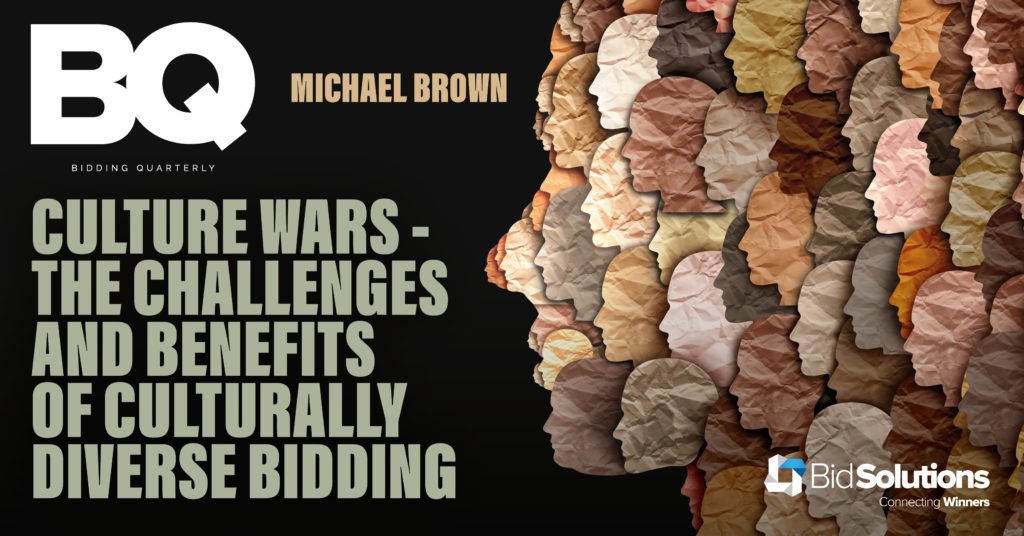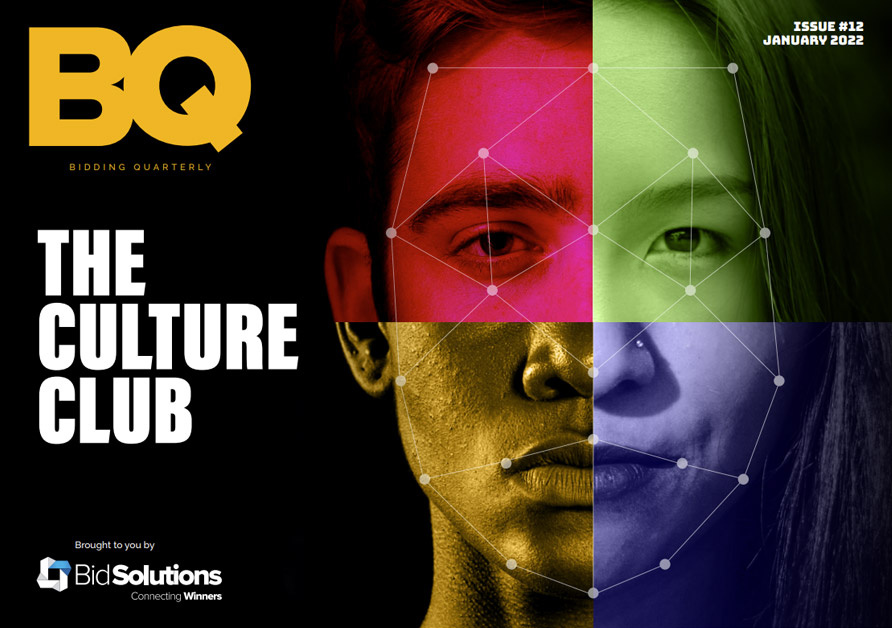
The Merriam-Webster dictionary defines culture as “The beliefs, customs, arts, etc, of a particular society, group, place, or time”.[1] What then is the best metaphor to use when discussing the impact of different cultures working on the same proposal or project? The melting pot? The salad bowl? The stew where it all mixes up and blends into one delicious fusion dish?
The impact of culture in the workplace is a complicated, sensitive, yet fascinating subject – particularly so in the world of bidding and proposals. This is because it has ramifications for both the teams doing the bidding and the clients procuring the services. This article touches on these two categories from the bidders’ and the clients’ points of view.
The internationalist
While I am not an expert in the study of culture, I understand this sits across a variety of academic disciplines such as anthropology and other social sciences. I do think I have a good starting point from my personal and professional background. Having been born in Zambia, grown up in Singapore and lived in nine countries, I consider myself an internationalist at heart.
On a professional level I have bid and won numerous projects in Europe, the Middle East, APAC and North America. I currently live in Singapore and have a global proposal role which ensures I am constantly grappling with the differing styles, behaviours and inclinations of bid teams and clients procuring our services. This constant need to adapt to the various teams’ styles keeps me on my toes, as well as constantly checking the local time in the places I need to arrange meetings in!
Diversity theory
The key takeaway point from all these international bidding experiences is a simple one that has its origins in diversity theory[2]. The point being made, which I have experienced in numerous real situations, is that a diverse team is better at producing a myriad of responses and perspectives and adapting to the needs of diverse clients – but only if the leadership of a company or team can adapt to and be flexible with the variety of styles and cultures in the team.
Mirroring your client
The reason why this works is fairly clear and obvious. You gain the best from multicultural teams operating across different geographies if you encourage flexibility and creativity. This is due to their ability to plug into their clients’ needs through empathy and understanding cultural norms. In short, culturally diverse bid teams mirror their culturally diverse multinational clients better than homogenous teams.
Diverse teams are not always easy
That said, flexibility and creativity can only go so far in the needs of an organisation with fixed internal processes and procedures. In the context of internal governance for example, what some think is a thorough explanation of a proposal may come across as either far too detailed or too vague to another team.
Are homogenous teams less likely to face such issues? Are expectations clearer from within the organisation with regards to levels of detail? This may indeed be the case especially in traditional industries such as construction and design; however, issues like these can be ironed out through setting clear expectations and providing templates, role descriptions, meeting agendas and minute clarity on the expectations of internal reviews.
Cultural diversity is here to stay – for good
Evidence from a range of studies shows increasing the diversity of leadership teams leads to more and better innovation and improved financial performance[3]. This is more important than any frustration around unwritten expectations or differing styles of work. I am a strong proponent for bid teams focusing on understanding their clients’ needs to understand the macroeconomic, social and political drivers for project procurement.
Diverse bid teams are far more likely to understand the nuances of client drivers than homogenous teams because they can empathise and innovate, just like their clients do. Understanding the clients’ touch points gives a bid team the ability to distinguish themselves from their competition.
Take the example of a highway construction project where a homogenous team made up of similar engineers are often fixated on the materials and specifications of the project. A diverse team is more likely to understand and communicate back to the client their understanding that the project is a vehicle to deliver a need (for example, to enable transportation of raw materials and connect previously cut off communities to the capital). Diverse teams are more likely to focus on demographics, culture, macroeconomics and more. Ultimate decision makers are less interested in minute specifics and more about whether the bidder understands the project needs and if they can work with the bidder for months or years.
Moving away from your comfort zone
Human nature gravitates towards the familiar. It is only natural for individual and team comfort zones to be what they are used to, whether this is in familiar cultures and norms or procedures. But a comfort zone does not lead to a winning mindset or attitude. By mirroring the increasing diversity of clients and their companies, bid teams must break out of the mould of regurgitating the same old solutions to clients. In doing so they are able to think outside the box and to think holistically about the impact of their solutions.
The increasingly competitive landscape of bidding can go one of two ways; a race to the bottom for price or distinguishing yourself from your competition through a high-level understanding of your client and tailoring the solution to that holistic understanding.
Aside from winning more, culturally diverse teams are also far more interesting to work with and for!
[1] https://www.merriam-webster.com/dictionary/culture
[2] Cognitive Diversity among Upper-Echelon Executives: Implications for Strategic Decision Processes (C. Chet Miller, Linda M. Burke, and William H. Glick).
[3] https://www.bcg.com/en-us/publications/2018/how-diverse-leadership-teams-boost-innovation
This article was written by Michael Brown.
Michael Brown is a seasoned bid professional having won multiple projects across the built environment throughout Europe, the Middle East, APAC and North America. He is passionate about leading global teams to deliver top quality proposals and pitches to multinational clients.

